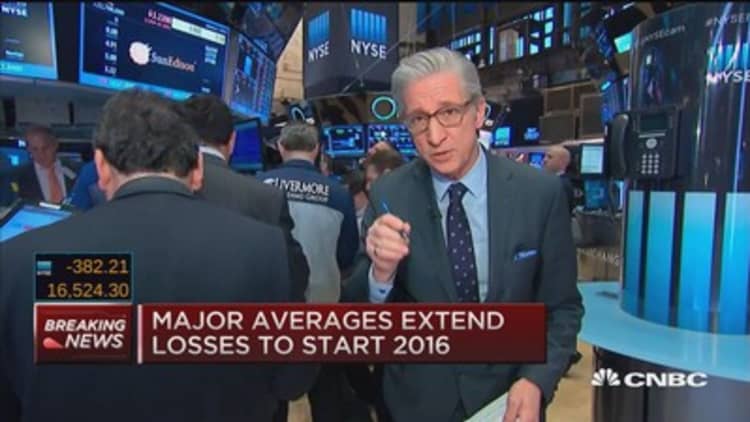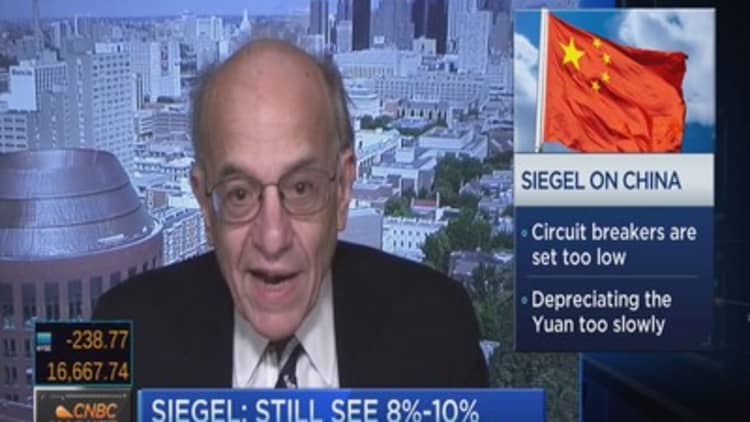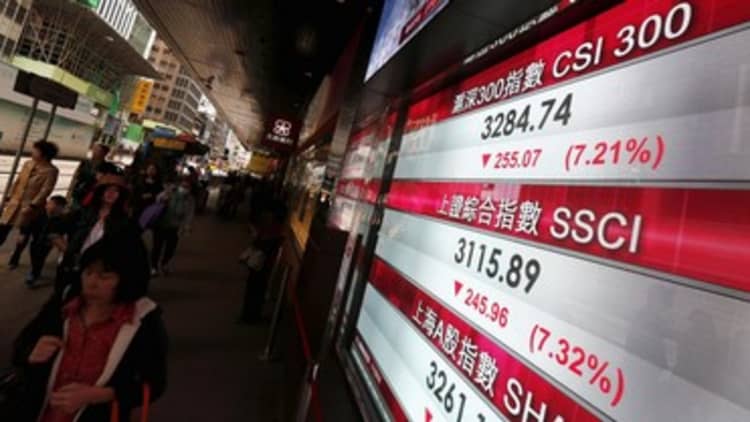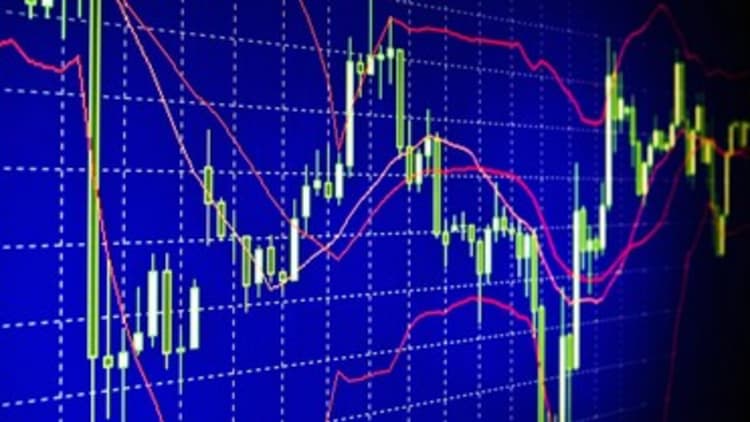





U.S. stocks closed sharply lower Thursday as China news overnight and low oil prices renewed concerns about global economic growth. Devaluation of the Chinese yuan and speculation of significantly more weakening in the currency also weighed on sentiment.
The Dow Jones industrial average closed down about 392 points, after earlier falling 442.88 points. The index ended more than 10 percent below its 52-week intraday high, in correction territory. The Nasdaq composite closed down 3 percent, also in correction territory. (Tweet This)
The S&P 500 ended more than 2 percent lower, about 9 percent away from its 52-week intraday high.
Read MoreMarket plunge: What you need to know
Stocks extended losses in early afternoon trade after Reuters reported, citing sources, that China's central bank is under increasing pressure from policy advisors to let the yuan currency fall quickly and sharply, by as much as 10-15 percent, as its recent gradual softening is thought to be doing more harm than good.
"Definitely the Reuters story was negative and hit the market pretty hard," said Ilya Feygin, senior strategist and managing director at WallachBeth Capital.
Traders also noted failure to hold technical levels and concerns ahead of potential Thursday night news.
Weighing on markets overnight was news the People's Bank of China set the yuan reference rate at 6.564, its lowest since 2011 and the largest daily change since Aug. 13, according to Reuters. A trade halt in China due to a circuit breaker also shook global markets.
"Another day here, another yuan devaluation. I don't think a lot has changed a whole lot coming into today except energy continues to go down," said Art Hogan, chief market strategist at Wunderlich Securities.
WTI settled down 70 cents, or 2.06 percent, at $33.27 a barrel, above session lows. Apple closed down 4.2 percent to $96.45 a share. The VIX briefly topped 25 to its highest since mid-December.
Gold futures for February delivery settled up $15.90 at $1,107.80 an ounce, helping the Gold Miners ETF (GDX) end up 4.4 percent.
Read MoreChina and its currency: 'They're riding a bronco'
As of Thursday's close, the major U.S. averages were down nearly 5 percent or more for the week, on pace for their worst since Aug. 21, 2015.
"Obviously it's really being driven right now by China and oil prices. It's been a flight to quality. ... It's not a whole lot different from what we saw last August," said John Bredemus, vice president, Allianz Investment Management.
"I don't get too concerned about a single day but we've had a couple days. This gives real concern if the U.S. economy can continue to go it alone (if) the rest of the world continues to slow," he said.
In mid-morning trade, the Dow regained more than half of an opening decline of 317.90 points after the China Securities Regulatory Commission suspended its recently implemented circuit breaker system Thursday morning ET. Overnight, a 7 percent drop in mainland Chinese indexes triggered a circuit breaker, with Chinese markets open for less than half an hour in total. The halt was the second in a week.
"I think China's suspending their circuit breaker rule was a great help ... The thinking is there's not going to be this mad rush to the opening bell," said Jeremy Klein, chief market strategist at FBN Securities.
The Shanghai composite fell 7 percent, while the Hang Seng closed down more than 3 percent. The Nikkei 225 was off 2.3 percent. European stocks closed more than 2 percent lower despite an intraday attempt to pare losses.
Dow futures briefly traded more than 400 points lower before holding about 350 points lower ahead of the open.
"China's a very important player in the current episode of market volatility, but market volatility will not necessarily come to a halt if China's market stabilizes," said John Lonski, chief economist at Moody's. "I still think we have a problem with excess production capacity and spending not growing rapidly enough to capture existing resources, including both capital and labor."
The World Bank on Wednesday cut its 2016 global growth forecast to 2.9 percent, citing pressure from "weak growth among major emerging markets." That estimate is up slightly from a 2.4 percent growth rate last year but down from the June forecast for 3.3 percent growth, Reuters said.
At oil's lows of the day, U.S. crude fell more than 3 percent to below $33 a barrel, a 12-year low. Brent also dipped below $33 a barrel, a near-12-year low.
"We are seeing a little bounce in oil prices. I do think we've got a long overdue bounce here," John Caruso, senior market strategist at RJO Futures, said of stocks' intraday attempt to pare losses. Still, he said, "I can't get bullish here. It's a stock-pickers' market."
Natural gas held more than 5 percent higher after inventory data showed a greater decline from the previous week.
Copper fell more than 3.5 percent in intraday trade to hit its lowest since Nov. 2015.
Dane Davis, copper analyst at Barclays, expects weak prices for the next five years as China demand for copper slows from 6 percent growth in 2014 to about 3 percent in 2015 and a forecast 2 percent rate this year.
"I think what's going on in the market is not where we are today but where we are tomorrow. The market is re-evaluating long-term where China demand will be," he said.
Read MoreHere are the 5 safest Dow stocks in the sell-off
In a light day of U.S. economic news, weekly jobless claims came in at 277,000. The highly anticipated December employment report is due Friday morning.
Chicago Federal Reserve President Charles Evans said in a Reuters report Thursday that the U.S. interest rate path in 2016 was consistent with two hikes, and cautioned that monetary policy must take into account the potential for lower economic growth in the long term.
Treasury yields held lower, with the near 0.93 percent and the 10-year yield at 2.15 percent in the close.
The U.S. dollar held nearly 1 percent lower against major world currencies, with the euro above $1.09 and the yen at 117.59 yen against the greenback.
Major U.S. Indexes
The Dow Jones industrial average closed down 392.41 points, or 2.32 percent, at 16,514.10, with General Electric leading decliners and Wal-Mart the only gainer.
The Dow transports closed down more than 3 percent, below 7,000 for the first time since November 2013. The index is off more than 20 percent from its 52-week high.
The closed down 47.17 points, or 2.37 percent, at 1,943.09, with information technology leading all 10 sectors lower.
The Nasdaq composite closed down 146.34, or 3.03 percent, at 4,689.43.
The CBOE Volatility Index (VIX), widely considered the best gauge of fear in the market, held near 25.
Nearly seven stocks declined for every advancer on the New York Stock Exchange, with an exchange volume of almost 1.2 billion and a composite volume of 5.05 billion.
Read More Early movers: JCP, WBA, HPQ, AAPL, M, FINL, LUV, MS & more
—Reuters contributed to this report.
On tap this week:
Friday
Earnings: Acuity Brands
8:30 a.m.: Nonfarm payroll, unemployment rate and average hourly wages
10 a.m.: Wholesale trade
11:30 a.m.: San Francisco Fed President John Williams speaks
1 p.m.: Rig count
1 p.m.: Richmond Fed President Jeffrey Lacker speaks
3 p.m.: Consumer credit and Treasury STRIPS
*Planner subject to change.
More From CNBC.com:


